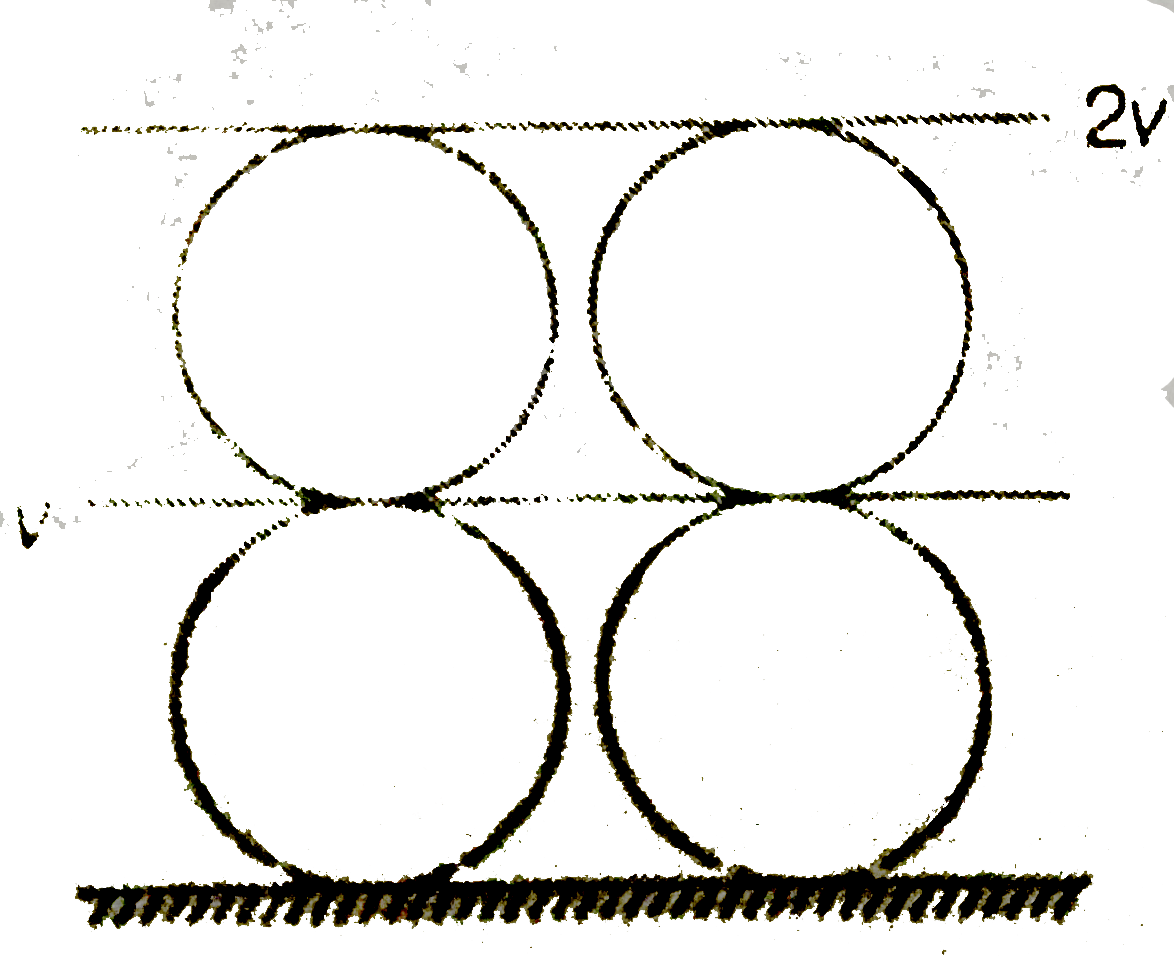A cylinder rotating at an angular speed of 50 rev/s is brought in contact with an identical stationary cylinder. Because of the kinetic friction, torques act on the two cylinders, accelerating the stationary one and decelerating the moving one. If the common magnitude of the acceleration and deceleration be one revolution per second square, how long will it take before the two cylinders have equal angular speed?Solution in Tamil
The correct Answer is:B
A cylinder is moving with an angular velocity 50 rev/s is brought in contact wikth another idencital cylinder in rest. The first and second cylinder has common acceleration and deceleration as 1rad/s^2 respectively.
let after 1 sec their angular velocity will be same ω.
For the first cylinder.
ω=50−at
→t=ω−501
and for the 2nd cylinder
→ω=α2t
→t=ωI
So, ω=(ω−50−1)
→2ω=50
→ω=25revs
→t=251sec=25sec.
Topper's Solved these Questions
- ROTATIONAL MECHANICSBOOK - HC VERMACHAPTER - ROTATIONAL MECHANICSEXERCISE - Objective -2
15 Videos
- REST AND MOTION : KINEMATICSBOOK - HC VERMACHAPTER - REST AND MOTION : KINEMATICSEXERCISE - Exercises
51 Videos
- SIMPLE HARMONIC MOTIONBOOK - HC VERMACHAPTER - SIMPLE HARMONIC MOTIONEXERCISE - Exercises
58 Videos
Similar Questions
The axis of rotation of a purely rotating body
View SolutionA man goes 10 m due east and then 24 m due north. Find the distance of his current position from the starting point ?
View SolutionA particle executes simple harmonic motion with an amplitude of 10 cm and time period 6s. At t=0 it is at position x=5 cm going towards positive x-direction. Write the equation for the displacement x at time t. Find the magnitude of the acceleration of the particle at t=4s.
View SolutionA cylinder rotating at an angular speed of 50 rev/s is brought in contact with an identical stationary cylinder. Because of the kinetic friction, torques act on the two cylinders, accelerating the stationary one nd decelerating the moving one. If the common magnitude decelerating the moving one. If the common magnitude of the acceleration and deceleration be one revolution per second sqrare, how long will it take before the two cylinders have equal angular speed?
View SolutionA solid cylinder of mass 20 kg rotates about its axis with angular speed 100 s^(-1) . The radius of the cylinder is 0.25 m . What is the kinetic energy associated with the rotation of the cylinder ? What is the magnitude of angular momentum of the cylinder about its axis ?
View SolutionTwo thin planks are moving on a four identical cylinders as shown. There is no slipping at any contact points. Calculate the ratio of angular speed of upper cylinder to lower cylinder

View Solution20 kg द्रव्यमान का कोई ठोस सिलिंडर अपने अक्ष के परितः 100 rad s−1 की कोणीय चाल से घूर्णन कर रहा है । सिलिंडर की त्रिज्या 0.25m है । सिलिंडर के घूर्णन से संबद्ध गतिज ऊर्जा क्या है ? सिलिंडर का अपने अक्ष के परितः कोणीय संवेग का परिमाण क्या है ?
View Solution20 किग्रा द्रव्यमान का कोई ठोस सिलेण्डर अपने अक्ष के परितः 100rad s− की कोणीय चाल से घूर्णन कर रहा है। सिलेण्डर की त्रिज्या 0.25 m है। सिलेण्डर के घूर्णन से संबद्ध गतिज ऊर्जा क्या है? सिलेण्डर का अपने अक्ष के परितः कोणीय संवेग का परिमाण क्या है?
View Solution50 चक्कर/सेकंड की कोणीय चाल से घूम रहा एक बेलन स्थिर अवस्था में स्थित एक अन्य सनान बेलन के संपर्क में लाया जाता है। दोनों बेलनों के अक्ष समानांतर है। गतिज घर्षण के वारण, दोनों बेलनों जिससे स्थिर बेलन त्वरित होता है तथा पर बल-आघूर्ण लगते गतिशील बेलन अवमंदित होता है। यदि त्वरग तथा अवमंदन दोनों का परिमाण 1 चक्कर/सेकंड2 हो, तो दोनों बेलनों की कोणीय चाल बराबर होने में कितना समय लगेगा
View SolutionA solid cylinder of mass 20kg rotates about its axis with angular velocity of 100 radian s−1. The radius of the cylinder is 0.25m. The magnitude of the angular momentum of the cylinder about its axis of rotation is
View SolutionConsider two cylinders with same radius and same mass. Let one of the cylinders be solid and another one be hollow. When subjected to some torque, which one among them gets more angular acceleration than the other?
View SolutionConsider two cylinders with same radius and same mass. Let one of the cylinders be solid and another one be hollow. When subjected to some torque, which one among them gets more angular acceleration than the other?
View SolutionA solid cylinder of mass 20 kg rotates about its axis with angular speed 100 rad s^(-1) . The radius of the cylinder is 0.25 m. What is the kinetic energy associated with the rotation of the cylinder? What is the magnitude of angular momentum of the cylinder about its axis?
View SolutionA solid cylinder of mass 20 kg rotates about its axis with angular speed 100 rad s^(-1) . The radius of the cylinder is 0.25 m. What is the kinetic energy associated with the rotation of the cylinder? What is the magnitude of angular momentum of the cylinder about its axis?
View SolutionA solid cylinder of mass 20 kg rotates about its axis with angular speed 100 rad s^(-1) . The radius of the cylinder is 0.25 m. What is the kinetic energy associated with the rotation of the cylinder? What is the magnitude of angular momentum of the cylinder about its axis?
View SolutionA solid cylinder of mass 20kg rotates about its axis with angular speed 100rad s^(-1) . The radius of the cylinder is 0.25m . What is the kinetic energy associated with the rotation of the cylinder? What is the magnitude of the angular momentum of the cylinder about its axis?
View Solution
